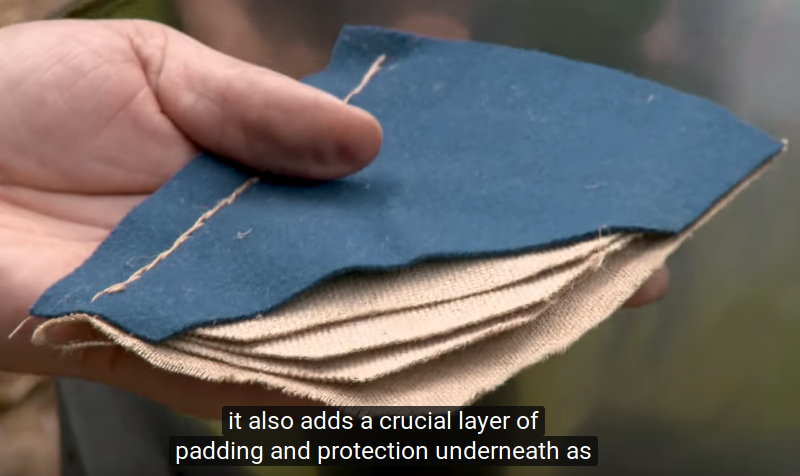Bowan12 wrote:Yeah, one thing which got me was the weakness of the arrow wood. You can make arrows much stronger than that and period arrows showed signs of heat hardening. I think you could get more 'punch' with stiffer arrows. I cant comment on the arrow head only that it's got some criticism from blacksmiths on the quality of the heat hardening, again medieval arrow-smiths would test things all the time and if there was an obvious area for improvement they would act upon it.
How does heat hardened aspen compare with unhardened ash?
Dan Howard wrote:3. If you shoot a bodkin-type arrow and a broadhead arrow, both of the same weight, from the same bow, the bodkin constantly outranges the broadhead.
Do we know that the bodkin arrowheads in use were the same weight as the military broadhead in common use? According to Pratt, the LM16/Jessop M4 averaged between 6.5 and 7.5 grams (British Museum and London Museum, respectively), while the LM7/8 weighed between 10 and 20 grams.
6. Sir John Smythe recommended a fourth of each sheaf be flight arrows to "gall" the enemy at range. We also have inventory references to "byker" arrows. Byker means to harass or irritate.
I can't find a reference in Smythe to archers carrying a number of arrows to gall the enemy at range. Are you thinking of Henry Barrett, who advocated the inclusion of 8 arrows that were "more flighter" in each sheaf for this purpose? The way he writes suggests that this wasn't common practice in 1562 and that he thought it was necessary to get the best out of the bow.
I haven't been able to find reference to "byker" arrows, but there seems to be some interference from a medieval fletcher surnamed "byker". Where's the best place to start looking?
Smythe gives a range for these arrows of 20-24 score (400-480) yards. He said that war arrows only travel 12 score (240) yards.
I think your source is quoting Smythe out of context. When he discusses using flight arrows, it's to use them as a way of discrediting claims of the musket's long range superiority:
If Mosquettiers may giue effectuall volees 24. scores of (as it is fondlie reported) then some number of Archers being chosen, that could with their flights shoote 24. or 20. scores (as there be manie that can) may by the same reason giue volees of flights at their enemies 18. scores of, which both the one & the other are mockeries to bee thought of, because there is no weapon in the field effectuall, further than to a conuenient and certen distance.
(
source)
I've been unable to find the instance of Smythe given the range of a war arrow as 240 yards; he provides 160-220 yards as the various points at which an archer might engage in long range shooting with war arrows. This seems to be
entirely consistent with 16th century estimates of the maximum practical range for military archery. Even Henry VIII's famous archery statute seems to have 220 yards as the maximum expected range for a military arrow, as this is the distance at which he allows the use of flight arrows.
7. There were no arrowheads found on the Mary Rose. All that remains is a rusty outline on the surface on which they were resting. But the rust pattern was analysed and the general shape could be determined with a lot of them. Out of these, around a quarter were bodkin-shaped and the rest were broadhead-shaped, which is the same ratio mentioned by Smythe.
Do you have a source for this? I may have missed it, but
Weapons of Warre doesn't provide any information on the types of arrowheads or their breakdowns beyond one archaeologist's notes that one find seemed to have bodkin heads. Has there been a more recent paper? I know there was at least one concretion of arrowheads; has it been x-rayed?
All this suggests to me that the compact broadhead was intended to be used against armour at shorter ranges and the bodkins were intended to be used on the flight arrows described by Smythe. These "byker" arrows were heavier than those used in competitions, but not as heavy as the armour piercers. If the bodkin typology was not meant for Smythe's flight arrows, then which one was?
I question this. Where we have information on medieval arrows that match your 1/4 proportion, they seem to be heavier than standard livery arrows. For instance, a 1475 indenture for Edward IV's expedition to France lists 350 sheaves of arrows with 9" fletchings (3.4%), 1750 sheaves of arrows with 8" fletchings (16.5%) and 7960 sheaves of arrows with 7" fletchings (75.1%). This is eerily similar to the proportions from the Mary Rose (17% for the 8" and 3.5% for the 9") and matches an inventory of Rouen Castle after the Duke of Bedford's death, where 26.8% of arrows were valued at 21.25d per sheaf and 73.2% were valued at 19.25d.
(all numbers are from Wadge's
Arrowstorm)
While this is very meagre evidence - although par for the course regarding the topic - I think it points much more strongly towards heavy, armour piercing arrowheads being the minority with the livery arrowheads having a military broadhead and making up most of the arrows an archer was issued.



